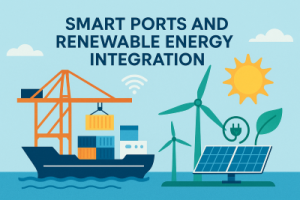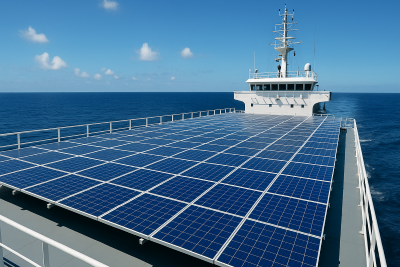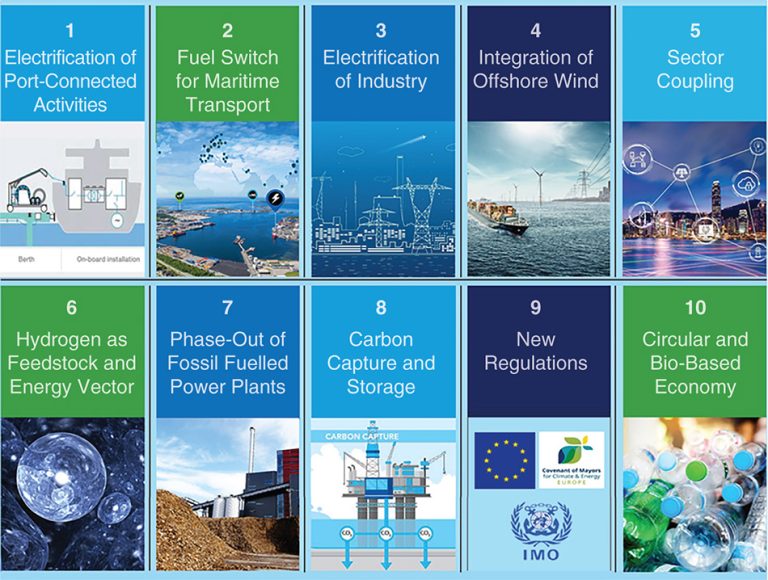Smart Ports and Renewable Energy Integration
Introduction
Ports serve as the vital centers of global commerce, managing over 80% of the world’s goods by volume. Nevertheless, they are also energy-heavy, historically dependent on fossil fuels for their operations. With the increasing global emphasis on sustainability, the maritime industry is progressively embracing intelligent port technology and the incorporation of renewable energy sources. This dynamic duo presents an effective approach to decrease emissions, enhance efficiency, and safeguard future operations. In this blog entry, we will explore the characteristics that define a “smart” port, how renewable energy is being incorporated, and what the future has in store for these technological wonders of maritime infrastructure. Whether you are a professional in the maritime field, a proponent of sustainability, or just someone with an interest, this guide aims to clarify complex concepts and inspire with tangible advancements.
What Are Smart Ports?

Smart ports utilize digital technologies, automation, and data analysis to optimize every aspect of port operations—from scheduling vessel arrivals to cargo management and energy consumption. These technologies comprise:
- Internet of Things (IoT): Real-time sensors that monitor cargo, assess equipment conditions, and streamline workflows.
- Artificial Intelligence (AI): Algorithms that anticipate traffic trends and alleviate congestion.
- Blockchain: Secure and transparent systems for tracking shipments and related documentation.
- 5G Connectivity: High-speed communication between devices and control systems.
By adopting these innovations, ports can shorten turnaround times, improve security, reduce operational costs, and—most importantly—significantly lower their environmental footprint.
Why Renewable Energy in Ports?
Traditionally, ports have relied on diesel generators, which contribute to air and noise pollution in nearby urban areas. As regulations become stricter and stakeholder expectations rise, ports are more frequently pursuing clean, renewable energy solutions to achieve sustainability goals. These sources include:
- Solar Power: Harnessed from rooftops, warehouses, and even floating installations on water.
- Wind Energy: Particularly effective in coastal regions with strong and steady wind patterns.
- Hydrogen Fuel Cells: Used to power port vehicles and potentially ships in the near future.
- Wave and Tidal Energy: Emerging energy sources that capitalize on a port’s marine environment.
By incorporating renewables, ports not only diminish emissions but also decrease long-term operational expenses and boost energy resilience.
How Smart Ports and Renewable Energy Work Together
While each aspect brings unique advantages, the collaboration between smart technologies and renewable energy fundamentally revolutionizes port operations. Here’s how they enhance one another:
- Energy Management Systems (EMS): Smart ports utilize EMS to track real-time energy generation (from solar panels or wind turbines) and consumption. This enables dynamic load balancing and peak shaving.
- Automated Equipment: Electric cranes and autonomous vehicles can be powered directly by onsite renewable energy, with smart grids optimizing their energy utilization.
- Predictive Maintenance: AI-driven systems can forecast when renewable infrastructure requires servicing, reducing downtime and maximizing efficiency.
- Shore Power (Cold Ironing): Vessels connect to renewable-powered shore grids instead of operating diesel engines, significantly reducing emissions while docked.
Therefore, smart infrastructure serves as the digital foundation that allows ports to effectively manage and optimize the integration of renewable energy.
Real-World Examples of Sustainable Green Ports
Numerous international ports have embarked on this path, providing motivating examples:
-
Port of Rotterdam, Netherlands
Regarded as the globe’s most advanced port, Rotterdam integrates IoT, AI, and blockchain technology to enhance shipping logistics. It harnesses wind energy and aspires to achieve carbon neutrality by 2050.
-
Port of Los Angeles, USA
Recognized for its commitment to sustainability, this port employs solar energy, electric cranes, and hydrogen fuel cell vehicles. Its intelligent systems track emissions and energy consumption in real time.
-
Port of Singapore
Being one of the busiest ports in the world, Singapore is developing the Tuas Mega Port, which incorporates digital twins, AI-driven traffic management, and integrated renewable energy systems, including solar and tidal sources. These examples illustrate how the fusion of digitalization with decarbonization can yield not only environmental benefits but also competitive edges in global commerce.
Advantages of Smart Ports with Renewable Energy Integration
When executed with care, smart ports fueled by renewable energy present a multitude of advantages:
| Advantage | Description |
| Emission Mitigation | A decrease in diesel dependency lowers CO₂, NOx, and SOx emissions. |
| Energy Optimization | Real-time monitoring aids in balancing energy loads and minimizing waste. |
| Operational Robustness | On-site renewable energy reduces reliance on grid power and fluctuations in fuel prices. |
| Cost Efficiency | Reduced energy expenses and maintenance costs over time. |
| Regulatory Adherence | Proactively meets IMO and local emissions standards. |
| Enhanced Community Relations | Cleaner ports contribute to better air quality and fewer grievances from local residents. |
Clearly, this shift benefits not just the environment but also economic performance.
Transitional Challenges
Despite the potential, moving towards a smart, renewable-energy-powered port comes with its challenges:
- High Initial Costs: Upgrading infrastructure and embracing digital transformation necessitates substantial financial investment.
- Technological Complexity: Incorporating various systems—energy, IT, logistics—requires thorough planning and skilled workforce.
- Regulatory Challenges: Regulations may lag behind advancements in technology, hampering adoption in specific areas.
- Cybersecurity Threats: Increased connectivity heightens the risk of cyber-attacks.
- Energy Storage: The variability of solar and wind energy necessitates dependable battery solutions, which can be expensive.
Nevertheless, many of these challenges are being mitigated through public-private partnerships, innovation grants, and international collaboration.
Policy and Regulatory Assistance
The effectiveness of intelligent ports with renewable energy integration also relies on favorable regulatory frameworks. Entities such as the International Maritime Organization (IMO) and the European Commission are establishing guidelines that promote green port projects.
Moreover, financial instruments like green bonds, carbon credits, and sustainability-linked loans are becoming increasingly available, providing ports with the financial flexibility needed to modernize responsibly.
The Path Forward: An Intelligent and Sustainable Maritime Future
As the urgency of climate change escalates and trade volumes rise, the demand for ports to adapt is only growing stronger. Smart ports that incorporate renewable energy are no longer optional—they are becoming essential for strategic planning.
We can anticipate the following developments in the years ahead:
- Increase in AI and Machine Learning applications for energy efficiency.
- Growth of Hydrogen Hubs to facilitate clean fuel transitions.
- Standardization of Digital Port Platforms to ensure global interoperability.
- Enhanced Utilization of Offshore Renewable Energy Farms linked directly to port microgrids.
- Cooperation Across Supply Chains to achieve decarbonization of logistics from start to finish.
The maritime sector is heading towards a more intelligent, eco-friendly future—and ports are at the helm.
Conclusion
The integration of smart ports and renewable energy marks a significant advancement towards sustainable maritime logistics. By adopting cutting-edge technologies and clean energy solutions, ports can improve efficiency, minimize environmental footprint, and uphold their crucial role in international trade.
While the process may be intricate, the goal—a cleaner, smarter, and more resilient port environment—is undoubtedly worthwhile. The future isn’t just arriving at our ports; it’s being energized and optimized through them




